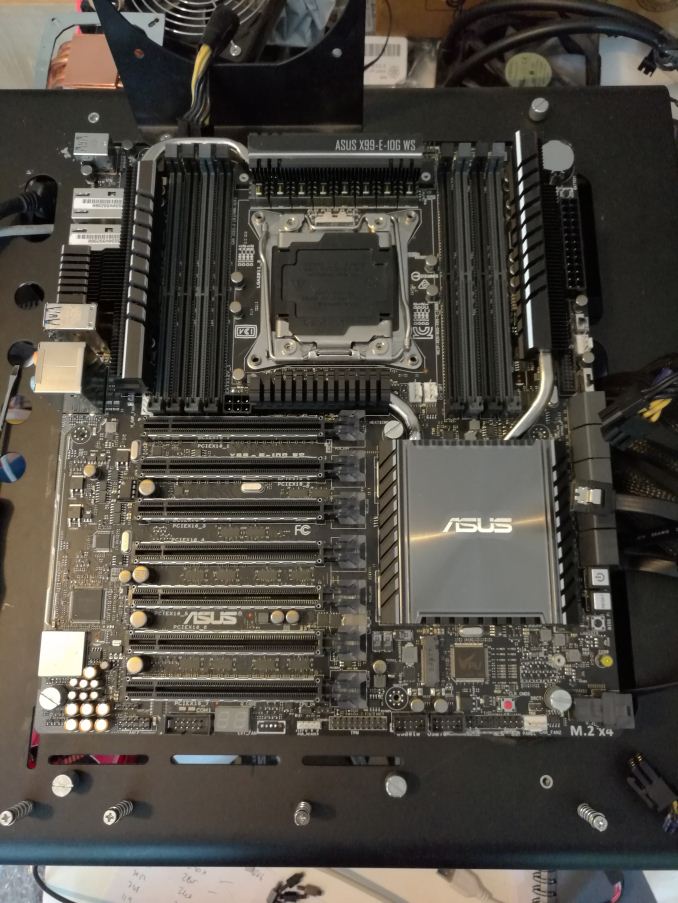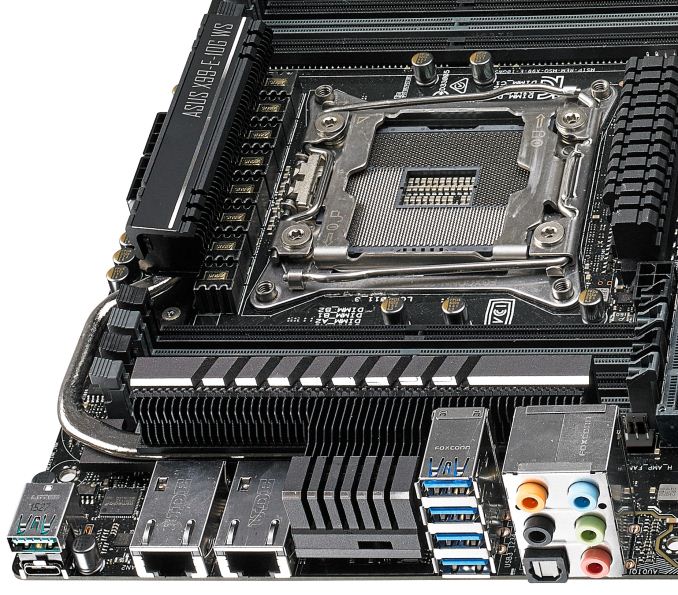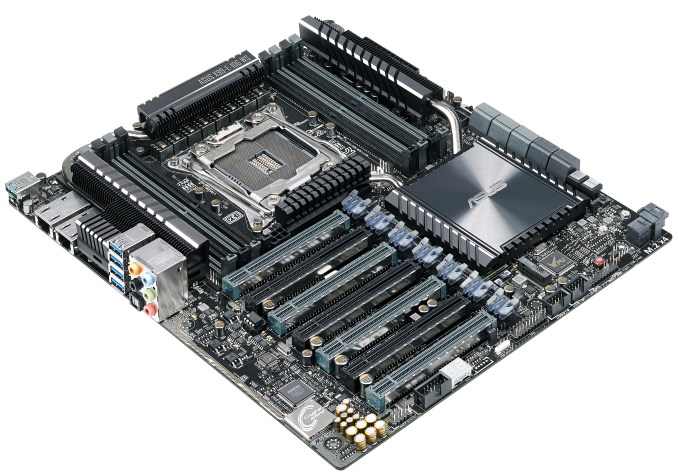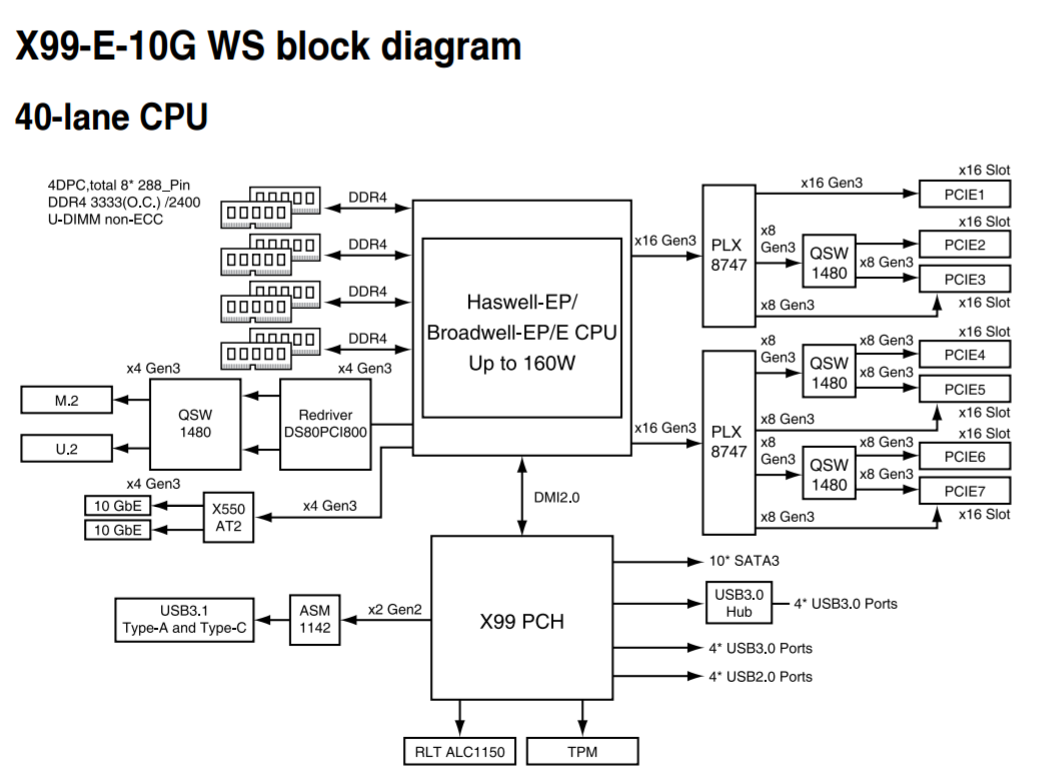ASUS X99-E-10G WS Motherboard Launched: Dual 10GBase-T Ethernet via an Integrated X550-AT2
by Ian Cutress on August 29, 2016 5:20 PM EST- Posted in
- Motherboards
- Asus
- Workstation
- Enterprise
- X99
- 10GBase-T

When we wrote up our list of 10GBase-T capable consumer motherboards back in July, we noted that out of the two main ways to get 10GBase-T on a motherboard, either by and add-in card or via an integrated controller, only one example of the latter existed on the market. For almost two years, that sole motherboard has been the only integrated solution – since then, ASUS launched the Maximus VIII Assembly which comes with a single port add-in card, and we saw a micro-ATX C236 model with a single port from MSI at Computex. We also listed the X99-E-10G WS from ASUS, a new board set to come to the market and we had an early sample. We’re still testing the board, but ASUS is officially announcing it today.
The X99-E-10G WS is built like a brick outhouse, with the focus on premium workstation parts and the latest set of features ASUS could put together while still under the X99 chipset banner, rather than a Xeon chipset. The board is designed for any Broadwell-E CPU, either consumer i7 or Xeon E5 v4, with extensive heatsink arrangements to carry both the Intel X550-AT2 controller (11W), the chipset, the upgraded power delivery and additional controllers.
The main feature is obviously the 10GBase-T ports, which are RJ45 compatible with most home and SMB networks. The X550-T2 controller is a PCIe 3.0 x4 part, which is an upgrade over the older X540-T2 generation that needed PCIe 2.0 x8 (and even at PCIe 3.0, you still needed 8 lanes due to controller limitations). This controller has a list price on Intel’s ARK of $80 for batches of 1000, however it probably adds nearer $100-$150 to the motherboard cost paid for by the end user. Alongside the Ethernet ports are a pair of 10 Gbps USB 3.1 ports (one Type-C), four USB 3.0 ports and the audio.
The board has full support for PCIe graphics, using dual PLX8747s as high-end PCIe switches. This allows support of x16/x16/x16/x16 slots (or x16/x8/x8/x8/x8/x8/x8) while also having enough bandwidth for the X550-T2 controller, a U.2 connector running at PCIe 3.0 x4 as well as an M.2 slot also at PCIe 3.0 x4. The PCIe slots have two additional features, with integrated guard rails in each of the slots to increase rigidity and reduce RMAs, but also the PCIe latches are translucent. When the system is turned on, the main PCIe slot connectors have a LED light that implements a slow breathing effect. Speaking with the motherboard product managers, it turns out that users do not often know which PCIe slots are suitable for maximum bandwidth, and this is designed to help.
The ASUS X99-E-10G WS also comes with 10 SATA 6 Gbps ports, dual USB 3.0 onboard headers, Dr. Power, BIOS Flashback, EZ XMP and an upgraded audio solution. ASUS expects the board to land with an MSRP of $650 with select authorized resellers and distributors soon.
Source: ASUS Edge Up




















40 Comments
View All Comments
Dug - Wednesday, August 31, 2016 - link
It's not a need. In fact you don't even NEED a computer.This is about speed, whether you need it or not.
You don't need an electric car that does 0-60 in 2.5 seconds, but yet they make it. There's no benefit except the joy of using it. Same when you have a 10gb network.
It's consumer driven by those that have the money and want the top 1% AND find ways to benefit from it.
What's funny is your lack of comprehension on how this could make people happy by saving time. Not unlike how some people disclaimed you didn't NEED an ssd. Nope you don't. And most consumers could care less saving a few seconds. But now it almost seems pointless not to have an SSD. Same thing with 10gb.
stux - Tuesday, September 20, 2016 - link
10gbe is about saving HOURS not seconds.As I type this I'm waiting for 10TB to transfer from one system to a new system... It should be done in a day or two.
zodiacfml - Tuesday, August 30, 2016 - link
Not much yet but they will come. This is already an issue with some Wi-Fi access points/routers as they can exceed beyond 1G. TP-Link has 802.11ad and its performance is limited by the Gigabit connection.NAS devices will eventually have SSDs in them.
testbug00 - Tuesday, August 30, 2016 - link
prosumer. QEDprisonerX - Tuesday, August 30, 2016 - link
"640K should be enough for anyone..."WinkDinkerson - Tuesday, August 30, 2016 - link
Hilarious.10Gbe is completely useless without large framing. Even if you managed to generate, say, 900 MegaBytes per second from Ethernet to Disk (SSD) somehow your system would actually be a laggy steaming pile while handling all those interrupts and high processor usage + the interrupts generated for the disk activity.
This is like mounting a jet engine on a car, facing forward, and then using said jet engine as a 'selling point'. Suckers gunna buy it and then when it fires up, the car is fighting against itself.
Lame. Leave it on server platforms where it belongs for now, consumers/gamers aren't ready for it.
alexdi - Tuesday, August 30, 2016 - link
Yes, hilarious. My 10GbE systems had no idea they were supposed to be so terrible. Please tell us more from your extensive experience.atomt - Tuesday, August 30, 2016 - link
Havin to use "large framing" for 10G has not been a issue for several (5+?) years. Not only are the CPUs faster, but OS/drivers have become much better at handling it, with things like bundling up smaller packets into giant packets before processing them, fetching/sending them in batches from/to the networking hardware using a single interrupt and so on.Samus - Tuesday, August 30, 2016 - link
Well, this is pure pornography.kgardas - Tuesday, August 30, 2016 - link
non-ECC RAM in workstation? This is no go. IMHO this is yet another gaming board. Otherwise board is really nice so I guess they will find some buyers...